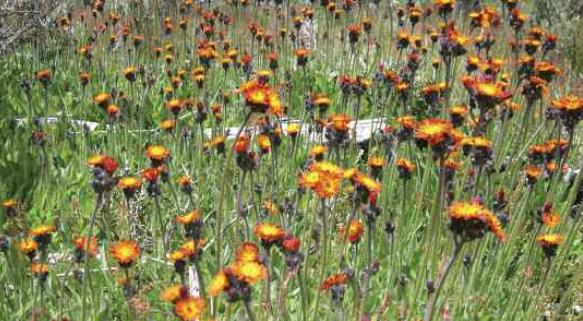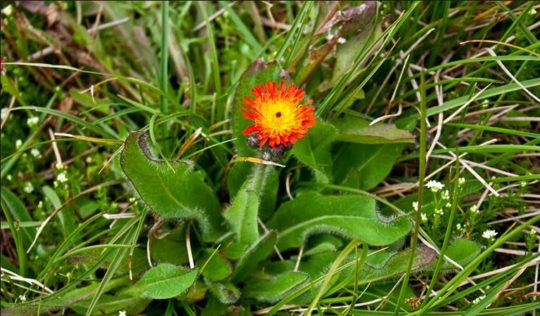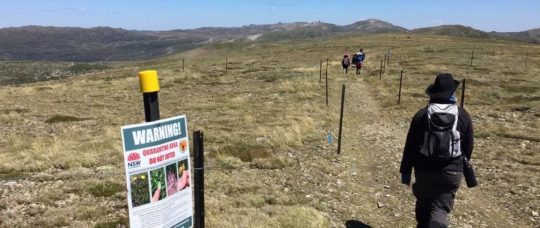Kosciuszko invaded by Orange Hawkweed
Sunday, October 22nd, 2017 Hikers to the Kosciuszko National Park were presumed to have inadvertently introduced seeds of Orange Hawkweed (also Mouse-Ear Hawkweed) (Hieracium aurantiacum), an evasive and noxious weed that has devastated ecology in New Zealand, the United States, and Canada.
Hikers to the Kosciuszko National Park were presumed to have inadvertently introduced seeds of Orange Hawkweed (also Mouse-Ear Hawkweed) (Hieracium aurantiacum), an evasive and noxious weed that has devastated ecology in New Zealand, the United States, and Canada.
Contaminated Hiker Mud
Hikers from around Australia and overseas can readily and inadvertently cause the spread of invasive plant species embedded in the mud and moisture on the soles of their boots and kit.
Australia’s biosecurity inspections invariably occur during customs checks of arrivals at international airports to quarrantine pest and diseases, and domestically the explicit warnings and occasional checks for fruit fly (Drosophila melanogaster) and Grape phylloxera (Daktulsphaira vitifoliae). But Australia has no monitoring of hike mud. Yet hiker mud can carry microscopic organisms – pests, weeds and disease-causing pathogens – that have the potential to devastate Australia’s natural environment.
Introduced invasive species can quickly contaminate and spread across a prestine ecological community because there is no natural resistence or predators agaist alien species. A minute amount of moisture or mud with contaminants on a hiking boot, gaiter, raincoat or tent peg can lead to infestation in the wild.
For instance, the African Chytrid amphibian fungus (Batrachochytrium dendrobatidis) poses a threat to Australia’s native frog species including Australia’s critically endangered Southern Corroboree Frog and the Stuttering Frog. The alien fungus has been detected at some places in Tasmania. It arrived into Australia in the early 1990s.
Listed as a notifiable disease, the fungus was first discovered in 1993 in dead and dying frogs in Queensland. The contagious fungal disease entered many countries after it was discovered a female African clawed frog injected with urine from a pregnant woman began ovulating within 12 hours. It was the first well-documented method of pregnancy testing and was used in the 1940s and 1950s. It is believed the fungus entered the ecosystem either through coming in contact with other amphibian species in laboratories or when the African clawed frog was disposed of after testing. Matt West, a spotted tree frog researcher at Melbourne University, said most of the data suggested the disease originated from Africa and came to Australia via the US.
Another threat is the pathogen called phytophthora, which attacks the roots of plants and can destroy entire vegetation communities. It too is already present in Tasmania.
Orange Hawkweed Infestation
The noxious weed Orange Hawkweed from southern Europe is believed to have been first introduced to Tasmania as a garden plant early in the 20th Century.
The weed dispersal and infestation is concentrated in Tasmania on the west coast around the mining towns of Queenstown, Gormanston and Zeehan and along the Lyell Highway which passes through the Tasmanian Wilderness World Heritage Area, notably downwind from the island’s prevailing westerly winds.
However, Orange Hawkweed was not recorded in mainland Australia until much later. In ‘Australian Vegetation’ (Keith 2017, 217), “Orange Hawkweed (Pilosella aurantiacum, syn. Hieracium)…was introduced to the Falls Creek ski resort village in Victoria (at 1600m) as a garden groundcover plant (probably in the 1980s). Orange hawkweed is prone to invade disturbed soil areas (eg roadsides, drains, residential areas), that is, areas of land-use development in which the dug up soil is left exposed to the sun with no vegetation rehabilitation. Roadmaking, road widening, sewage trenching and housing construction all typically have no interest in vegetation rehabilitation after they’ve done their work.
Horticultural Industry Weeds
So how did it get from Tasmania to Falls Creek? A commercial nursery planting out the weed at one of the ski resorts? Which one?
How and why did Australia Quarantine (Biosecurity) let Orange Hawkweed into Australia?
Surely the cost of Orange Hawkweed eradication ought to be invoiced to the Falls Creek resort village owners for them to recoup from the horticulturalist and recover costs from the wealthy ski tourist holiday makers by way of some surcharge or levy. Cause befits the massive clean up!
Orange Hawkweed spread to adjoining sub-alpine vegetation (Morgan 2000) , and new populations have been detected at Mount Buller and around Mount Jagungal in NSW (at 2060m) in Kosciuszko National Park. ”

So how did Orange Hawkweed spread from Falls Creek 100km NE to Mount Jagungal as the crow flies? Contaminated hikers boots? Cross-country skiers?
“Exotic plants and pathogens introduced into Australia have had significant impacts on species, vegetation communities and on ecological processes. There are more than 2700 exotic plant species that have become ‘naturalised’ within Australia and of those, 250 are considered problematic. The sources of the introduction have shifted from Europe, Australasia and North America to South America more recently, with the vast majority of introductions associated with the horticultural industry.” (Keith 2017, 207) [Refer to note in Further Reading below].
The seeds cast by the SW prevailing wind is most likely. Orange hawkweed spreads by runners over short distances and by seed carried by the wind over larger areas. The winds in the Victorian alps can be galeforce. The Victorian Government ignored the scientific advice from the 1990s and subsequent and annual germination and dispersal of Orange Hawkweed seed by strong winds toward the north east tundra grasslands were predicted and happened.
Now the delayed cost of pest eradication is a hundred fold.
It is well documentated that Hawkweeds are extremely invasive overseas; ten species have already become weed problems in New Zealand and several hundred species are known worldwide.
In alpine areas Orange Hawkweed out competes native grasses and disturbs local tundra ecosystems, by infilling spaces between native grass tussocks so denying seed regeneration of the native species. Orange hawkweed is on the Alert List for Environmental Weeds, a list of 28 non-native plants that threaten biodiversity and cause other environmental damage.
Orange hawkweed is a potential threat in the alpine country and the temperate tablelands of eastern Australia. It has become a noxious weed in Kosciuszko National Park, threatening Australian native plants and biodiversity. The orange hawkweed control programme by the New South Wales National Parks and Wildlife Service involves volunteers surveying infestation sites in the park, and then removing flowering heads and applying herbicides to reduce density and help to prevent spread.
 Orange Hawkweed – note the furry leaves!
Orange Hawkweed – note the furry leaves!
Source: ^http://www.nationalparks.nsw.gov.au/conservation-programs/orange-hawkweed-control-program
Further Reading:
[2] ‘Orange Hawkweed (Hieracium aurantiacum) – Weed Management Guide‘, 2003, (website), by CRC for Australian Weed Management and the Commonwealth Department of the Environment and Heritage. Document: >https://www.habitatadvocate.com.au/wp-content/uploads/2019/06/Orange-hawkweed-Hieracium-aurantiacum-Weed-Management-Guide-Australian-Government-2003.pdf. Source: ^https://www.environment.gov.au/biodiversity/invasive/weeds/publications/guidelines/alert/pubs/h-aurantiacum.pdf
[4] ‘A Dispersal Constrained habitat for Hawkweed on Mt Bogong‘, by the Victorian Government – Parks Victoria (department), October 2007, Document: >A Dispersal Constrained habitat for Hawkweed on Mt Bogong (Parks Victoria 2007). Source: ^https://parkweb.vic.gov.au/__data/assets/pdf_file/0015/314502/19_2070.pdf
[5] ‘Hawkweed (Invasive Species)‘, (website), by the Tasmanian Government-Department of Primary Industries, Parks Water and Environment (etc), ^https://dpipwe.tas.gov.au/invasive-species/weeds/weeds-index/declared-weeds-index/hawkweed
[6] ‘Plants Banned from Sale in South Australia – List‘, July 2017. Document: >https://www.habitatadvocate.com.au/wp-content/uploads/2019/06/Plants-Banned-from-Sale-in-SA-List-July-2017.pdf. Source: ^https://www.pir.sa.gov.au/__data/assets/pdf_file/0003/242715/Plants_banned_from_sale_in_SA_list_-_July_2017.pdf
[7] ‘Improved Detection and Eradication of Hawkweed‘ Oct 2011, Document: >https://www.habitatadvocate.com.au/wp-content/uploads/2019/06/Improved-Detection-and-Eradication-of-Hawkweed-Oct-2011.pdf. Source: ^https://www.agrifutures.com.au/wp-content/uploads/publications/11-058.pdf
[8] ‘Australian Vegetation‘, 2017, 3ed, by David A. Keith ed., authors Michelle R. Leishman, Rachael V. Gallagher, Jane A. Catford, Tony Grice, John W. Morgan, and Samantha Setterfield, of University of New South Wales, Ch. 9.2.3.4 ‘Invasive Plants and Pathogens in Australia – Alpine Zone‘, p.217, published by Cambridge University Press.










